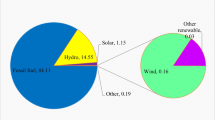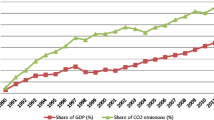Abstract
In the present (twenty-first) century, the pertinent challenge of attaining the regime of food security with low pollution amidst the drive for sustainable economy and energy efficiency is core to governance and intergovernmental agencies. Therefore, in an attempt to investigate environmental issues among the coastline Mediterranean countries (CMCs) for the first time, the current study examines the dynamic long-run nexus of carbon dioxide (CO2) emissions with food production and inflation rate over the annual period 1995–2014. Using a dynamic Autoregressive Distributed Lag (ARDL) approach, the consumption of renewable energy in the panel of sixteen (16) CMCs is empirically observed to be an efficient policy vehicle for mitigating CO2 emissions. Also, in all the examined CMCs, consumption of renewables is observed to cause significant decline in CO2 emissions, thus securing a sustainable environment. However, in the long run and in the panel of CMCs, the study reveals that increase in food production (a drive toward food security) increases environmental risk. Additionally, the study found that high inflation regime in the panel CMCs is associated with low CO2 emissions especially in the long-run, thus necessitating efficient policy mechanism. In adopting the genetic resources of the International Treaty on Plant Genetic Resources, as well as employing price control policy, the members of the CMCs might have unearthed a suitable policy directive in effectively sustaining environmental quality.



Similar content being viewed by others
Notes
More details relating to the Paris Agreement of 2015 is contained is available at: https://unfccc.int/process/conferences/pastconferences/paris-climate-change-conference-november-2015/paris-agreement.
References
Alam A, Azam M, Abdullah AB, Malik IA, Khan A, Hamzah TAAT, Zaman K (2015) Environmental quality indicators and financial development in Malaysia: unity in diversity. Environ Sci Pollut Res 22(11):8392–8404
Al-Mulali U, Ozturk I, Solarin SA (2016) Investigating the environmental Kuznets curve hypothesis in seven regions: the role of renewable energy. Ecol Indic 67:267–282
Alola AA (2019a) The trilemma of trade, monetary and immigration policies in the United States: Accounting for environmental sustainability. Sci Total Environ 658:260–267
Alola AA (2019b) Carbon emissions and the trilemma of trade policy, migration policy and health care in the US. Carbon Manag 10(2):209–218
Alola AA, Alola UV (2018) Agricultural land usage and tourism impact on renewable energy consumption among Coastline Mediterranean Countries. Energy Environ 29(8):1438–1454
Alola AA, Alola UV (2019) The dynamic nexus of crop production and population growth: housing market sustainability pathway. Environ Sci Pollut Res 26(7):6472–6480
Alola AA, Alola UV, Saint Akadiri S (2019a) Renewable energy consumption in coastline Mediterranean countries: impact of environmental degradation and housing policy. Environ Sci Pollut Res 1-13
Alola AA, Bekun FV, Sarkodie SA (2019b) Dynamic impact of trade policy, economic growth, fertility rate, renewable and non-renewable energy consumption on ecological footprint in Europe. Sci Total Environ 685:702–709
Alola AA, Yalçiner K, Alola UV, Saint Akadiri S (2019c) The role of renewable energy, immigration and real income in environmental sustainability target. Evidence from Europe largest states. Sci Total Environ 674:307–315
Bekun FV, Alola AA, Sarkodie SA (2019a) Toward a sustainable environment: Nexus between CO2 emissions, resource rent, renewable and nonrenewable energy in 16-EU countries. Sci Total Environ 657:1023–1029
Bekun FV, Emir F, Sarkodie SA (2019b) Another look at the relationship between energy consumption, carbon dioxide emissions, and economic growth in South Africa. Sci Total Environ 655:759–765
Benavente JMG (2016) Impact of a carbon tax on the Chilean economy: a computable general equilibrium analysis. Energy Econ 57:106–127
Bloomberg (2019). Canadian inflation picks up to 2% on Trudeau’s carbon levies. https://www.bloomberg.com/news/articles/2019-05-15/canadian-inflation-picks-up-to-2-on-trudeau-s-carbon-levies. Accessed 25 July 2019
Bölük G, Mert M (2015) The renewable energy, growth and environmental Kuznets curve in Turkey: an ARDL approach. Renew Sust Energ Rev 52:587–595
British Petroleum (BP) 2018) BP statistical review of world energy. https://www.bp.com/en/global/corporate/energy-economics/statistical-review-of-world-energy/downloads.html. (Accessed 20 March 2019)
Davidson EA, Suddick EC, Rice CW, Prokopy LS (2015) More food, low pollution (Mo Fo Lo Po): a grand challenge for the 21st century. J Environ Qual 44(2):305–311
Dejuán Ó, Zafrilla JE, Tobarra MÁ, Monsalve F, Córcoles C (2017) Decarbonizing electricity generation in Europe: Its impact on emissions and employment all over the world. In Environmental and Economic Impacts of Decarbonization (pp. 25-40). Routledge
Destek MA, Sarkodie SA (2019) Investigation of environmental Kuznets curve for ecological footprint: the role of energy and financial development. Sci Total Environ 650:2483–2489
Dumitrescu EI, Hurlin C (2012) Testing for Granger non-causality in heterogeneous panels. Econ Model 29(4):1450–1460
Ekins P (1994) The impact of carbon taxation on the UK economy. Energy Policy 22(7):571–579
Fernández FG, Terry RE, Coronel EG (2015) Nitrous oxide emissions from anhydrous ammonia, urea, and polymer-coated urea in Illinois cornfields. J Environ Qual 44(2):415–422
Galli A, Iha K, Halle M, El Bilali H, Grunewald N, Eaton D, Bottalico F (2017) Mediterranean countries’ food consumption and sourcing patterns: an ecological footprint viewpoint. Sci Total Environ 578:383–391
Grossman GM, Krueger AB (1995) Economic growth and the environment. Q J Econ 110(2):353–377
Hanif I (2018) Impact of economic growth, nonrenewable and renewable energy consumption, and urbanization on carbon emissions in Sub-Saharan Africa. Environ Sci Pollut Res 25(15):15057–15067
Im KS, Pesaran MH, Shin Y (2003) Testing for unit roots in heterogeneous panels. J Econ 115(1):53–74
Intergovernmental Panel on Climate Change (IPCC) (2014) http://www.ipcc.ch/report/ar5/syr/. (Accessed 19 March 2019)
International Renewable Energy Agency (IRENA) (2018). Renewable capacity statistics 2018. http://www.irena.org/. (Accessed 19 March 2019)
Jarecki MK, Hatfield JL, Barbour W (2015) Modeled nitrous oxide emissions from corn fields in Iowa based on county level data. J Environ Qual 44(2):431–441
Jebli MB, Youssef SB (2015) The environmental Kuznets curve, economic growth, renewable and non-renewable energy, and trade in Tunisia. Renew Sust Energ Rev 47:173–185
Levin A, Lin CF, Chu CSJ (2002) Unit root tests in panel data: asymptotic and finite-sample properties. J Econ 108(1):1–24
Lutz SR, Mallucci S, Diamantini E, Majone B, Bellin A, Merz R (2016) Hydroclimatic and water quality trends across three Mediterranean river basins. Sci Total Environ 571:1392–1406
Marignani, M., Bruschi, D., Garcia, D. A., Frondoni, R., Carli, E., Pinna, M. S., ..., Queller, E. M. (2017). Identification and prioritization of areas with high environmental risk in Mediterranean coastal areas: a flexible approach. Sci Total Environ 590:566-578
Nguyen KH, Kakinaka M (2019) Renewable energy consumption, carbon emissions, and development stages: Some evidence from panel cointegration analysis. Renew Energy 132:1049–1057
Norse D, Ju X (2015) Environmental costs of China’s food security. Agric Ecosyst Environ 209:5–14
Pata UK (2018) Renewable energy consumption, urbanization, financial development, income and CO2 emissions in Turkey: testing EKC hypothesis with structural breaks. J Clean Prod 187:770–779
Pesaran MH, Shin Y, Smith RP (1999) Pooled mean group estimation of dynamic heterogeneous panels. J Am Stat Assoc 94(446):621–634
Saint Akadiri S, Alola AA, Akadiri AC, Alola UV (2019) Renewable energy consumption in EU-28 countries: policy toward pollution mitigation and economic sustainability. Energy Policy 132:803–810
Segurado P, Almeida C, Neves R, Ferreira MT, Branco P (2018) Understanding multiple stressors in a Mediterranean basin: combined effects of land use, water scarcity and nutrient enrichment. Sci Total Environ 624:1221–1233
Serpa D, Nunes JP, Keizer JJ, Abrantes N (2017) Impacts of climate and land use changes on the water quality of a small Mediterranean catchment with intensive viticulture. Environ Pollut 224:454–465
Snyder CS, Bruulsema TW, Jensen TL, Fixen PE (2009) Review of greenhouse gas emissions from crop production systems and fertilizer management effects. Agric Ecosyst Environ 133(3-4):247–266
Tanrivermis H (2003) Agricultural land use change and sustainable use of land resources in the Mediterranean region of Turkey. J Arid Environ 54(3):553–564
United Nations Environment Program (UNEP) (2018) Global trends in renewable energy investment 2018. https://fs-unep-centre.org/publications/global-trends-renewable-energy-investment-report-2018. (Accessed 20 March 2019)
Uzuner G, Adewale AA (2019) Does asymmetric nexus exist between agricultural land and the housing market? Evidence from non-linear ARDL approach. Environ Sci Pollut Res 26(8):7677–7687
Velthof GL, Kuikman PJ, Oenema O (2003) Nitrous oxide emission from animal manures applied to soil under controlled conditions. Biol Fertil Soils 37(4):221–230
World Bank Indicator (2018) https://data.worldbank.org/indicator (Accessed 19 March 2019)
Zalidis G, Stamatiadis S, Takavakoglou V, Eskridge K, Misopolinos N (2002) Impacts of agricultural practices on soil and water quality in the Mediterranean region and proposed assessment methodology. Agric Ecosyst Environ 88(2):137–146
Zhang YJ (2011) The impact of financial development on carbon emissions: an empirical analysis in China. Energy Policy 39(4):2197–2203
Acknowledgments
Author’s gratitude is extended to the editor and anonymous reviewers that will/have spared time to guide toward a successful publication.
Author information
Authors and Affiliations
Corresponding author
Ethics declarations
Conflict of interest
The author wishes to disclose here that there are no potential conflicts of interest at any level of this study
Additional information
Responsible editor: Philippe Garrigues
Publisher’s note
Springer Nature remains neutral with regard to jurisdictional claims in published maps and institutional affiliations.
Appendix
Appendix
Rights and permissions
About this article
Cite this article
Alola, A.A., Yalçiner, K. & Alola, U.V. Renewables, food (in)security, and inflation regimes in the coastline Mediterranean countries (CMCs): the environmental pros and cons. Environ Sci Pollut Res 26, 34448–34458 (2019). https://doi.org/10.1007/s11356-019-06576-y
Received:
Accepted:
Published:
Issue Date:
DOI: https://doi.org/10.1007/s11356-019-06576-y




